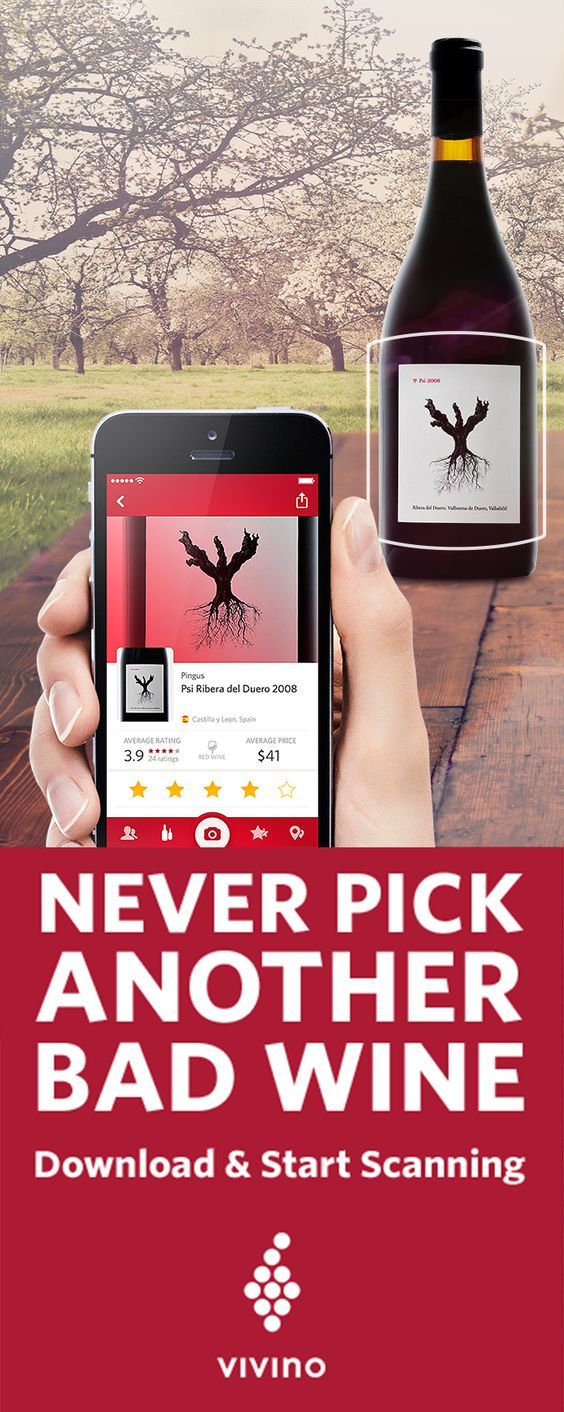Never pick another bad wine
Vivino • July 14, 2020
Learn more about Vivino Ratings.

Stop drinking bad wine, start using the Vivino app! Scan any wine label or wine list, and instantly find ratings, reviews, prices and food pairings for that wine. Trusted by over 19 million users, Vivino will help you find and remember the wines you love and avoid the wines you don't. Download the app today!
WHY SERVE WINE AT SPECIFIC TEMPERATURES? Wines and have specific layers of flavor that can only be fully enjoyed when they’re experienced at the proper temperature. Wine served too cold will dull taste bud sensation so you aren’t able to detect subtleties. Ron Dougherty, former Executive Director of the Raise a Glass Foundation and 13-year Head Judge at the Finger Lakes International Wine Competition, says that: temperature affects how we taste different compounds in foods and beverages – salt becomes less pronounced as foods get colder while acids become more pronounced. In wine the three key temp-affected components are alcohol, acid and aromatics. The ‘burn’ of alcohol on our palate decreases as temperature decreases. Vodka is a very good example of this – the same vodka will be very ‘hot’ at room temp but far less at freezer temp. And aromatic compounds become more noticeable as temperature increases. —Ron Dougherty, personal correspondence Of course, careful control of temperatures should start with the way you store your wine, long before you serve it. Here are some helpful hints for the proper storage of your wines: 5 TIPS FOR STORING WINE: Start off with the right storage temperature. Keep it cool, but not too cool. The optimal storage temperature range is 45–65°F (7–18°C) with 55°F (13°C) being cited as the perfect temperature. Average refrigerator temperature is below 40°F (4°C). At that low of a temperature the humidity level drops, the cork can dry out, and air from the fridge can seep into the bottle, damaging the wine. Storing at temperatures 70°F (21°C) or above can cause aromas and flavors to go flat. Avoid dramatic temperature swings. A trip home from the wine store isn’t going to harm your bottle, but leaving it in your car all day in the middle of the summer sure might. Wine should be stored away from direct light—that’s why so many wine bottles are tinted. Just like a pair of sunglasses, the tint helps reduce the penetration of UV rays. Exposure to light can cause degradation of flavors. Store your wine horizontally. Wine is traditionally stored sideways to keep the cork from drying out, but this isn’t necessary if it will be consumed in a short period of time. Keep your wine humid. 50–80% humidity in the storage area is considered optimal. Any higher and mold can grow on the corks and under the foil. (If you want to monitor your wine cellar or fridge, you can use our Thermo Hygrometer.) Keep your wine still. Too much jostling can cause chemical reactions in the wine, and sediment in older wines will be disturbed. SERVING TEMPERATURES: Once you’ve properly taken care of your bottle of wine, be sure its integrity is maintained on its journey to the glass by serving it at the right temperature. There are a lot of wines out there, but you don’t have to be an expert to grasp the basics. There are some general guidelines you can follow for wine temperatures, and Dougherty recommends the following temperature scheme: White Wines 45–49°F (7–9°C) Red Wines 56–60°F (13–16°C) Rosé Wines 48–52°F (9–11°C) Sparkling Wines 43–47°F (6–8°C) Dessert Wines 48–52°F (9–11°C) Fortified Wines 53–57°F (12–14°C)
Restaurants, retailers, and wine shops have been color-classifying wine for years: red, white, and rosé. However, a wine’s color is more important and far more complex than three simple categories on a supermarket shelf. Observing a wine’s color can be a valuable clue for determining the vintage, asessing the wine’s quality, and (most importantly) kicking butt on a blind tasting challenge! The Complete Wine Color Chart shows 36 unique color states of red, white, and rosé wines, which are organized by hue and intensity. Use this chart to become familiar with the full color hue spectrum that you can observe in a wine glass and to pick up the specific terminology that we can use to describe a wine’s color. Wine Color Facts Here are some fascinating details about color in wine. Red wines lose color as they age, turning more garnet in color and eventually turning brown. As much as 85% of anthocyanin (the color pigment in red wine) is lost after 5 years of aging (even if the wine still appears quite red). White wines darken as they age, turning a deeper gold or yellow color and eventually turning brown. Red wines that are more opaque generally contain higher levels of tannin (Nebbiolo is an exception to this rule). Red wines with higher sulfite additions have reduced color intensity. Red wines fermented at higher temperatures will have reduced color intensity. Rosé wines are stained pink by macerating the skins of red grapes over an average period of 4 hours to 4 days. Oxidation in wine causes it to become brown (like an apple left out on the kitchen counter too long). The hue in red wine is partially affected by the pH level of the wine. There are many variables that will affect the color (such as co-pigmentation, sulfur additions, etc.) but the following is generally true: Wines with a strong red hue have a lower pH (high acidity). Wines with a strong violet hue range from around 3.4–3.6 pH (on average). Wines with a blueish tint (magenta) are usually over 3.6 pH (lower acidity).